Diode-Pumped Actively Q-Switched Nd:YVO4/RTP Intracavity Raman Laser at 1.49 µm
Abstract
:1. Introduction
2. Experimental Setup
3. Experimental Results and Discussion
4. Conclusions
Author Contributions
Funding
Conflicts of Interest
References
- Olsson, N.; Van Der Ziel, J.P. Performance characteristics of 1.5-µm external cavity semiconductor lasers for coherent optical communication. IEEE J. Lightwave Technol. 1987, 5, 510–515. [Google Scholar] [CrossRef]
- Patterson, E.M.; Roberts, D.W.; Gimmestad, G.G. Initial measurements using a 1.54-μm eyesafe Raman shifted lidar. Appl. Opt. 1989, 28, 4978–4981. [Google Scholar] [CrossRef]
- Chen, X.H.; Zhang, X.Y.; Wang, Q.P.; Li, P.; Liu, Z.J.; Cong, Z.H.; Li, L.; Zhang, H.J. Highly efficient double-ended diffusion-bonded Nd:YVO4 1525-nm eye-safe Raman laser under direct 880-nm pumping. Appl. Phys. B 2012, 106, 653–656. [Google Scholar] [CrossRef]
- Murray, J.T.; Powell, R.C.; Peyghambarian, N.; Smith, D.; Austin, W.; Stolzenberger, R.A. Generation of 1.5-μm radiation through intracavity solid-state Raman shifting in Ba(NO3)2 nonlinear crystals. Opt. Lett. 1995, 20, 1017–1019. [Google Scholar] [CrossRef] [PubMed]
- Dashkevich, V.I.; Shpak, P.V.; Voitikov, S.V.; Chulkov, R.V.; Grabtchikov, A.S.; Cheshev, E.A.; EI-Desouki, M.; Orlovich, V.A. Eye-safe actively Q-switched diode-pumped lasers with intracavity Raman conversion in YVO4, KGd(WO4)2, PbWO4, and Ba(NO3)2 crystals. Opt. Commun. 2015, 351, 1–8. [Google Scholar] [CrossRef]
- Zverev, P.G.; Murray, J.T.; Powell, R.C.; Reeves, R.J.; Basiev, T.T. Stimulated Raman scattering of picosecond pulses in barium nitrate crystals. Opt. Commun. 1993, 97, 59–64. [Google Scholar] [CrossRef]
- Chen, Y.F. Compact efficient all-solid-state eye-safe laser with self-frequency Raman conversion in a Nd:YVO4 crystal. Opt. Lett. 2004, 29, 2172–2174. [Google Scholar] [CrossRef]
- Chang, Y.T.; Su, K.W.; Chang, H.L.; Chen, Y.F. Compact efficient Q-switched eye-safe laser at 1525 nm with a double-end diffusion-bonded Nd:YVO4 crystal as a self-Raman medium. Opt. Express 2009, 17, 4330–4335. [Google Scholar] [CrossRef]
- Shen, H.B.; Wang, Q.P.; Zhang, X.Y.; Liu, Z.Y.; Bai, F.; Cong, Z.H.; Chen, X.H.; Wu, Z.G.; Wang, W.T.; Gao, L.; et al. Simultaneous dual-wavelength operation of Nd:YVO4 self-Raman laser at 1524 nm and undoped GdVO4 Raman laser at 1522 nm. Opt. Lett. 2012, 37, 4113–4115. [Google Scholar] [CrossRef]
- Major, A.; Aitchison, J.S.; Smith, P.W.E.; Langford, N.; Ferguson, A.I. Efficient Raman shifting of high-energy picosecond pulses into the eye-safe 1.5-µm spectral region by use of a KGd(WO4)2 crystal. Opt. Lett. 2005, 30, 421–423. [Google Scholar] [CrossRef]
- Wang, Z.P.; Hu, D.W.; Fang, X.; Zhang, H.J.; Xu, X.G.; Wang, J.Y.; Shao, Z.S. Eye-safe Raman laser at 1.5 µm based on BaWO4 crystal. Chin. Phy. Lett. 2008, 25, 122. [Google Scholar] [CrossRef]
- Fan, Y.X.; Liu, Y.; Duan, Y.H.; Wang, Q.; Fan, L.; Wang, H.T.; Jia, G.H.; Tu, C.Y. High-efficiency eye-safe intracavity Raman laser at 1531 nm with SrWO4 crystal. Appl. Phys. B 2008, 93, 327–330. [Google Scholar] [CrossRef]
- Galli, P.; Gorini, G.; Mantica, P.; Hogeweij, G.M.D.; de Kloe, J.; Lopes Cardozo, N.J. ‘Non-local’ response of RTP ohmic plasmas to peripheral perturbations. Nucl. Fusion 1999, 39, 1355–1368. [Google Scholar] [CrossRef]
- Tu, C.S.; Guo, A.R.; Tao, R.; Katiyar, R.S.; Guo, R.; Bhalla, A.S. Temperature dependent Raman scattering in KTiOPO4 and KTiOAsO4 single crystals. Appl. Phys. 1996, 79, 3235. [Google Scholar] [CrossRef]
- Michael, V.P.; Darrell, J.A.; Arlee, V.S. Measurement of the χ(2) tensors of KTiOPO4, KTiOAsO4, RbTiOPO4, and RbTiOAsO4 crystals. Appl. Opt. 2004, 43, 3319–3323. [Google Scholar] [CrossRef]
- Zhu, H.Y.; Duan, Y.M.; Wang, H.Y.; Shao, Z.H.; Zhang, Y.J.; Zhang, G.; Tang, D.Y.; Zhang, J. Compact Nd:YAlO3/RbTiOPO4 based intra-cavity optical parametric oscillator emit at 1.65 and 3.13 μm. IEEE J. Sel. Top. Quantum Electron. 2014, 21, 1600105. [Google Scholar] [CrossRef]
- Qiao, J.P.; Zhao, S.Z.; Yang, K.J.; Li, G.Q.; Li, D.C.; Li, T.; Qiao, W.C.; Lu, J.R.; Chu, H.W.; Luan, C. Theoretical and experimental studies on coexistent OPO and SRS from a KTiOPO4 pumped by an AO Q-switched Nd:LGGG laser. Appl. Phys. B 2016, 122, 2–7. [Google Scholar] [CrossRef]
- Meng, P.B.; Yao, B.Q.; Zhu, G.L.; Ju, Y.L.; Wang, Y.Z. RTP Q-switched 2 μm Tm,Ho:GdVO4 Laser. Laser Phys. 2011, 21, 94–96. [Google Scholar] [CrossRef]
- Yu, Y.J.; Chen, X.Y.; Wang, C.; Wu, C.T.; Liu, R.; Jin, G.Y. A 200 kHz Q-Switched adhesive-free bond composite Nd:YVO4 laser using a double-crystal RTP electro-optic modulator. Chin. Phys. Lett. 2012, 29, 024206. [Google Scholar] [CrossRef]
- Pearce, S.; Ireland, C.L.M.; Dyer, P.E. Solid-state Raman laser generating <1 ns, multi-kilohertz pulses at 1096 nm. Opt. Commun. 2006, 260, 680–686. [Google Scholar] [CrossRef]
- Duan, Y.M.; Zhu, H.Y.; Zhang, Y.J.; Zhang, G.; Zhang, J.; Tang, D.Y.; Kaminskii, A.A. RbTiOPO4 cascaded Raman operation with multiple Raman frequency shifts derived by Q-switched Nd:YAlO3 laser. Sci. Rep. 2016, 6, 33852. [Google Scholar] [CrossRef] [PubMed]
- Duan, Y.M.; Zhang, J.; Zhu, H.Y.; Zhang, Y.C.; Xu, C.W.; Wang, H.Y.; Fan, D.Y. Compact passively Q-switched RbTiOPO4 cascaded Raman operation. Opt. Lett. 2018, 43, 4550–4553. [Google Scholar] [CrossRef] [PubMed]
- Tnomas, P.A.; Mayo, S.C.; Watts, B.E. Crystal structures of RbTiOAsO4, KTiO(P0.58,As0.42)O4, RbTiOPO4 and (Rb0.465,K0.535)TiOPO4, and analysis of pseudosymmetry in crystals of the KTiOPO4 family. Acta Cryst. B 1992, 48, 401–407. [Google Scholar] [CrossRef]
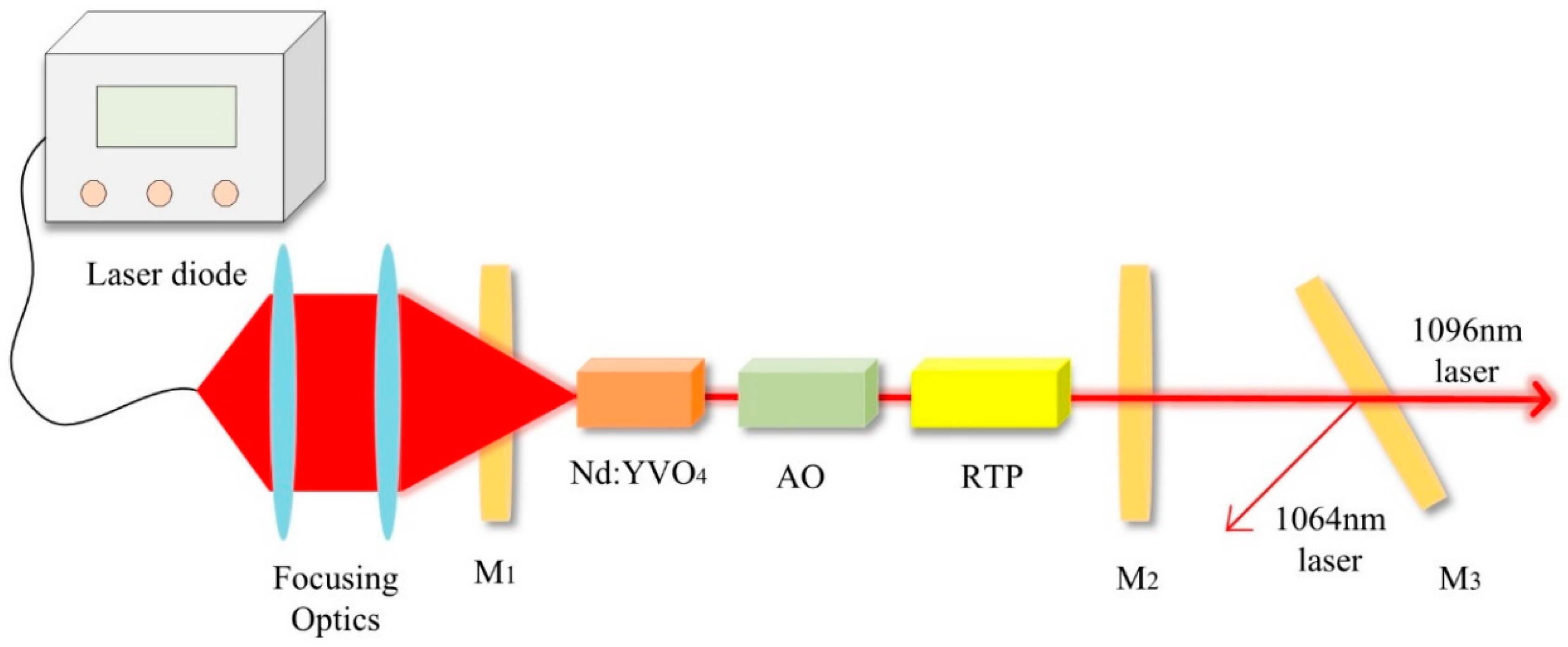
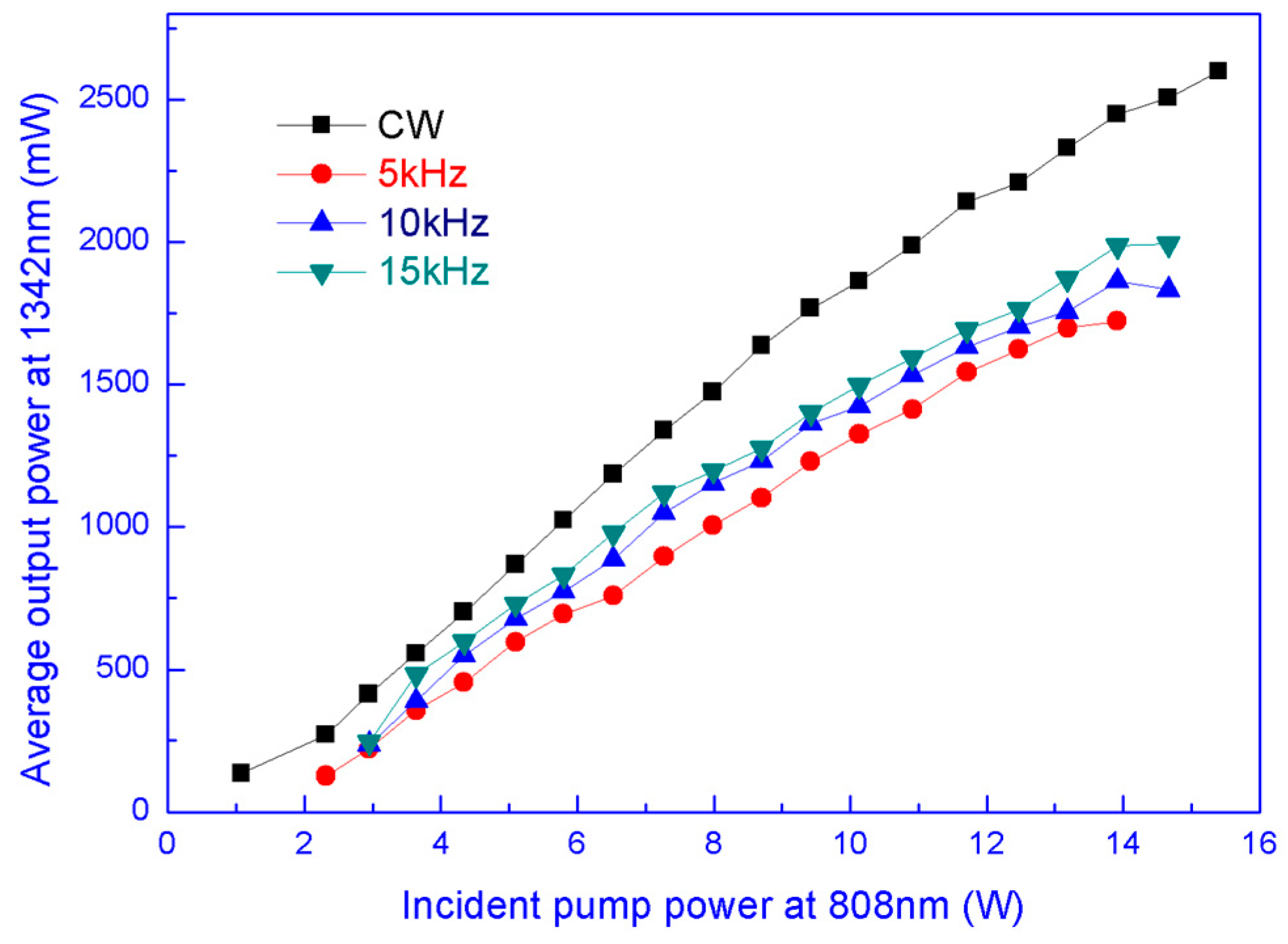
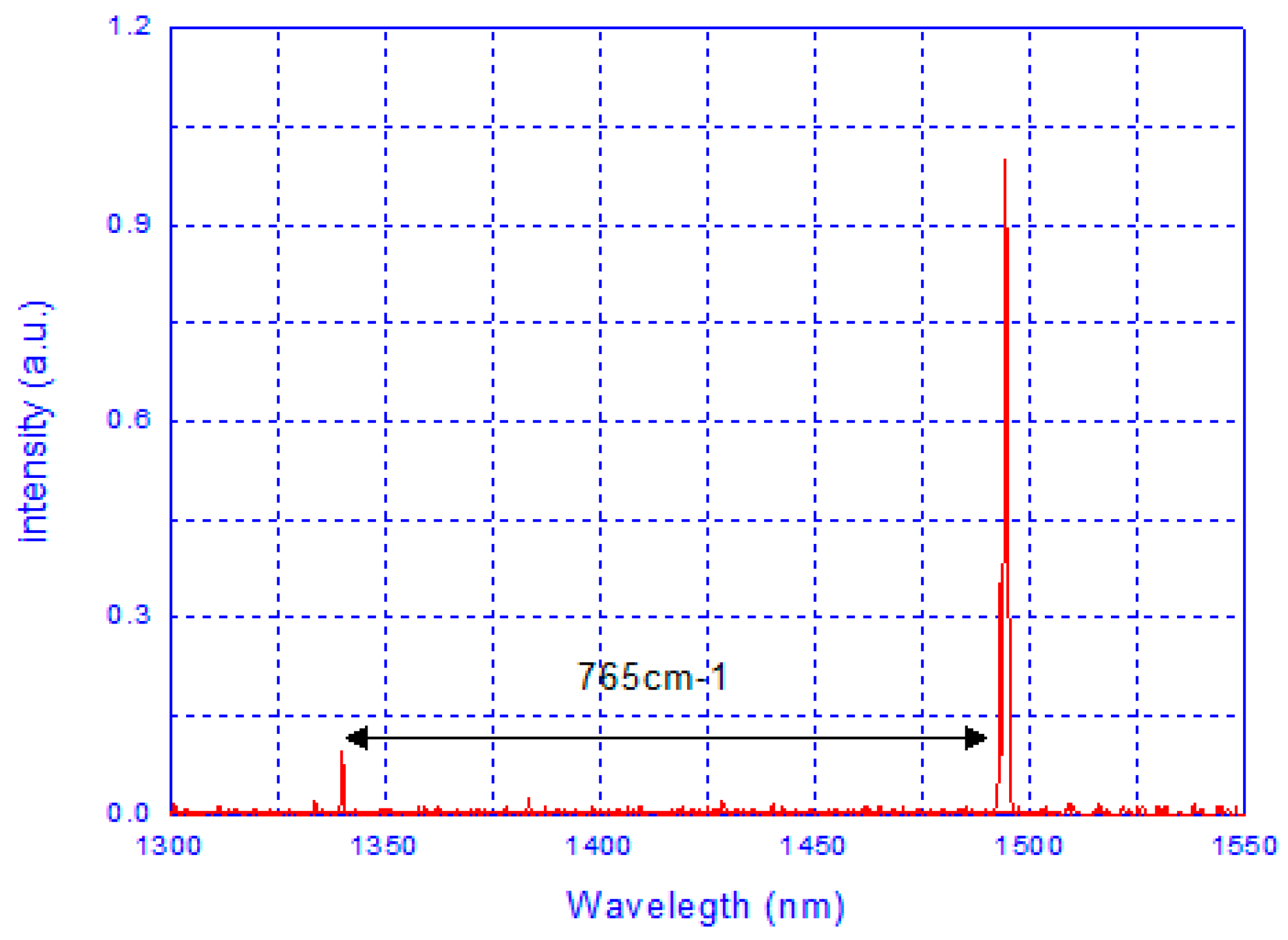
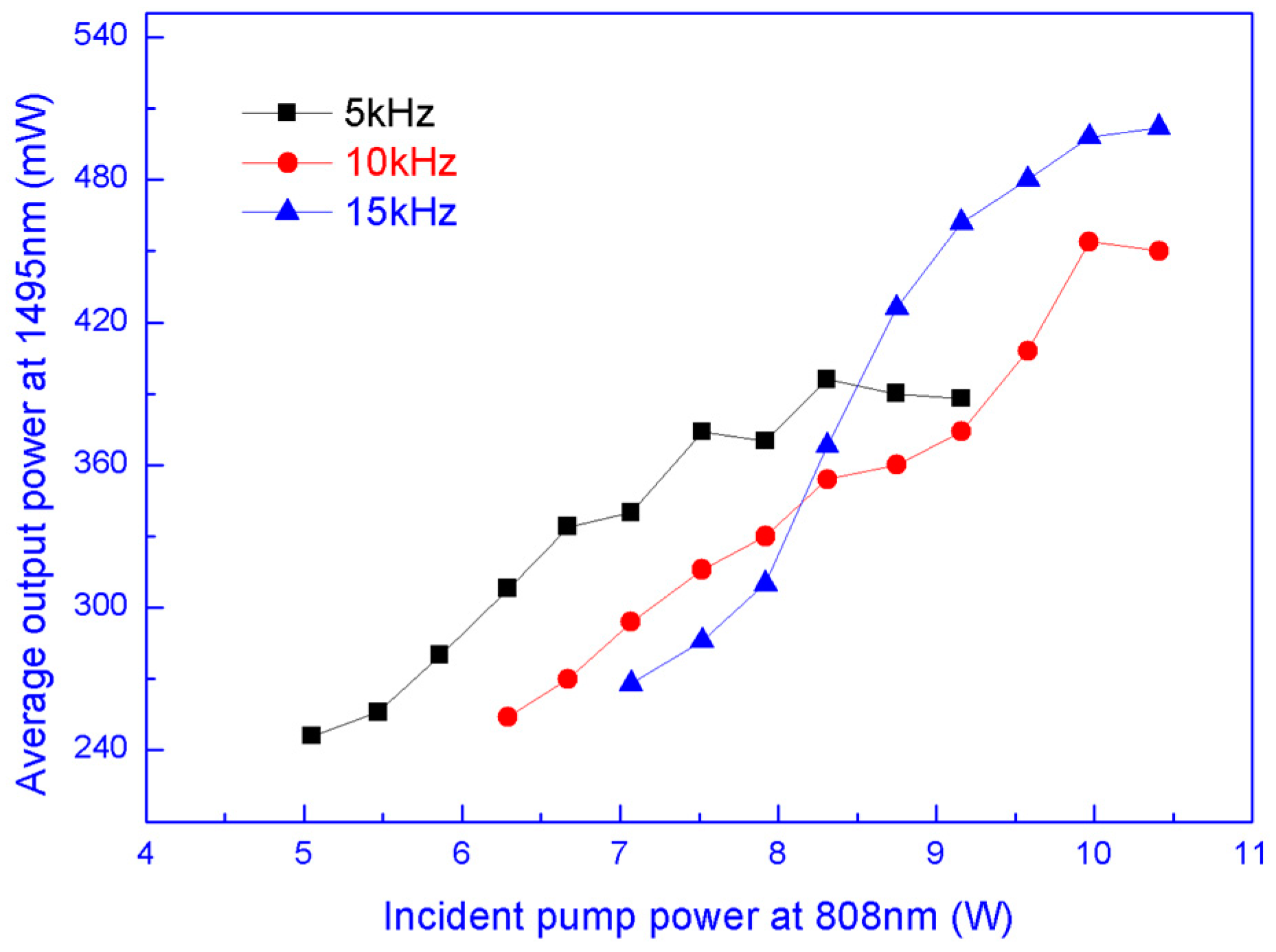

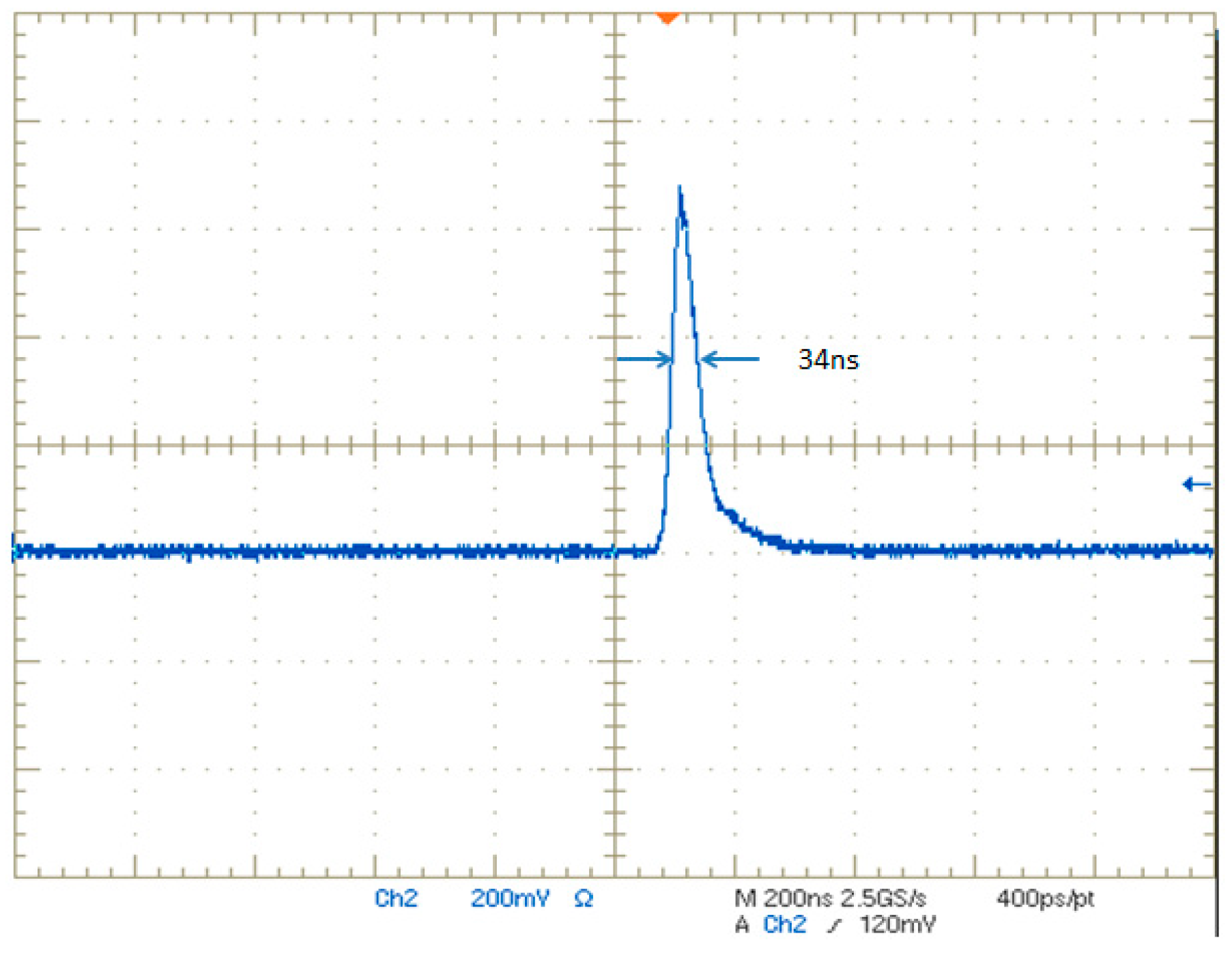
© 2019 by the authors. Licensee MDPI, Basel, Switzerland. This article is an open access article distributed under the terms and conditions of the Creative Commons Attribution (CC BY) license (http://creativecommons.org/licenses/by/4.0/).
Share and Cite
Jiao, Y.; Liu, Z.; Zhang, X.; Gao, F.; Jia, C.; Chen, X.; Cong, Z. Diode-Pumped Actively Q-Switched Nd:YVO4/RTP Intracavity Raman Laser at 1.49 µm. Crystals 2019, 9, 168. https://doi.org/10.3390/cryst9030168
Jiao Y, Liu Z, Zhang X, Gao F, Jia C, Chen X, Cong Z. Diode-Pumped Actively Q-Switched Nd:YVO4/RTP Intracavity Raman Laser at 1.49 µm. Crystals. 2019; 9(3):168. https://doi.org/10.3390/cryst9030168
Chicago/Turabian StyleJiao, Yue, Zhaojun Liu, Xingyu Zhang, Feilong Gao, Chenyang Jia, Xiaohan Chen, and Zhenhua Cong. 2019. "Diode-Pumped Actively Q-Switched Nd:YVO4/RTP Intracavity Raman Laser at 1.49 µm" Crystals 9, no. 3: 168. https://doi.org/10.3390/cryst9030168
APA StyleJiao, Y., Liu, Z., Zhang, X., Gao, F., Jia, C., Chen, X., & Cong, Z. (2019). Diode-Pumped Actively Q-Switched Nd:YVO4/RTP Intracavity Raman Laser at 1.49 µm. Crystals, 9(3), 168. https://doi.org/10.3390/cryst9030168




